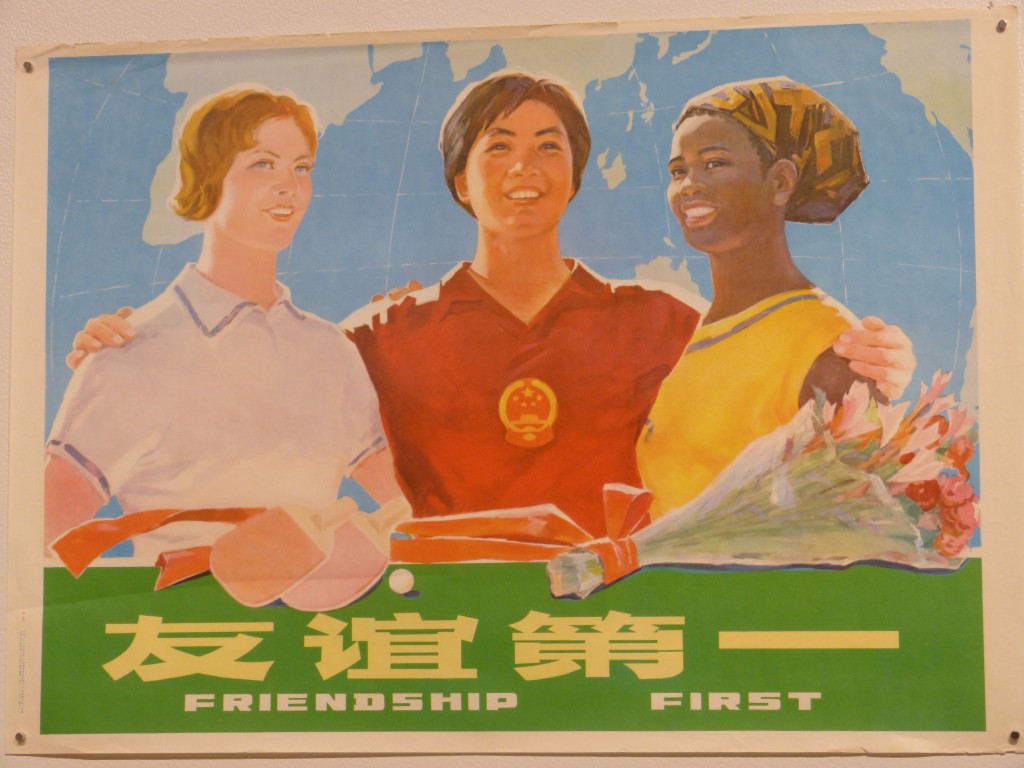Friendship First
Offset print, 1972
The Layered Motives of Ping-Pong Diplomacy
Friendship First presents a shining, optimistic vision: three women of diverse backgrounds, brought together by amicable ping-pong competition. The 1971 poster hints at a globalized utopia, in which cooperation and individual victory are anything but mutually exclusive. Yet, the unknown artist was simply fueling Mao’s less-than-benevolent propaganda machine – interestingly, in a way that complemented America’s foreign policy as well.
Most of the space in the print is taken up by depictions of a Caucasian (presumably American) woman on the left, a Chinese woman in the middle, and a woman of African descent on the far right. The Chinese woman has her arms wrapped around the other two, suggesting her centrality as well as her capacity for unification. Other than their ethnic identifying features, they are cut from the same mold, possessing the same height, body size, slight androgenization, and proud smile. It is notable, though, that the Chinese woman features a specific emblem of her national identity – a jersey stylized like the Chinese flag – while the nationality of the other two women is ambiguous, hinting at the vapidity of the international sentiment.
The women provide the foreground for a pale world map, which does not represent any national boundaries, but does include latitudinal and longitudinal lines. Above a bold Chinese/English caption bearing the title of the work lies two ping-pong paddles and a bouquet of flowers, symbolizing the dual, complementary forces of competition and friendship.
At first glance, it would appear to be a tribute to progressive politics. The image seems to glorify racial diversity, as well as female empowerment, in the context of international cooperation. Surely it evidences some genuine commitment to the ideal of women holding up half the sky. However, the self-interest motivating the print’s creation is unquestionable. So-called “ping-pong diplomacy” was an international power play, presumably to curry favor with the United Nations, but more fundamentally to reach out to Richard Nixon. The US had maintained a stance of distrust since Mao’s ascension to power, committed to their fear of all incarnations of socialism and the potential for a “domino effect.” Yet the geopolitical climate of the late 20th century forced both the US and China to re-evaluate their contempt of one another. For China, “better relations with the United States offered… two major advantages: some deterrence against the Soviet threat, and the possibility of bringing Taiwan back under Beijing’s control” (Guoqi 123). The increased hostility from the USSR, a veritable superpower, rendered a standoff with America unsustainable and dangerous. Sports in China were not exactly in a golden age — in fact, “several top ping-pong players committed suicide in 1967 after being humiliated and tortured by the Red Guards” (127). The country’s participation in international sports leagues was minimal, and they had skipped the World Table Tennis Federation Championship games during the peak years of the Cultural Revolution. But 1971 became the year that marked China’s renewed interest in table tennis. With that interest came a series of fateful interactions between the Chinese and American teams.
At the thirty-first World Championship competition of 1971, an exchange of gifts between American player Glenn Cowan and reigning champion Zhuang Zedong made a public spectacle of Sino-American cooperation (Guoqi 132). Before the games ended, Mao issued a formal invitation for the American team to visit China, which they enthusiastically accepted. To the delight of both nations, the Soviet Union was dumbfounded. A successful visit from the American team led them to reciprocate with the Chinese team, and invite them to the US. The visits proved to be deeply consequential; the diplomatic link between the two countries was sufficiently strong that even when the US renewed its plan to bomb North Vietnam – while the Chinese team was in America and vulnerable to bad press – “the team’s meeting with Nixon and the plan to give pandas to the United States [went] on as scheduled” (160). The mutual benefit of their mended relationship could not be denied, so transgressions that would have been demonized a few years before were overlooked in the wake of reconciliation.
Ping-pong diplomacy provided an effective model for future rapprochements. Other East Asian nations followed suit, employing ping-pong diplomacy to combat isolationist tendencies and form alliances. A similar tactic was employed in 1984 between China and South Korea, marking “the first time Korean athletes had competed on Chinese soil, even though the two countries had met before at international sports meets” (162). China was able to use ping-pong as a tentative step toward internationalization, an essential phase in its political and economic expansion.
As a piece of propaganda art, Friendship First speaks to the complex motives underlying China’s allegedly innocent passion for ping-pong. The piece contributed to the web of symbolic value that table tennis held in the domestic and geopolitical spheres in the 1970s. The poster may depict an overly idyllic fantasy of intercultural cooperation, but the pragmatic gains of ping-pong diplomacy were very real, preparing the way for the globally integrated China we know now.
Abby Grosse
Select Bibliography
Xu, Guoqi, Olympic Dreams: China and Sports (Cambridge: Harvard University Press, 2008), 117-164.
